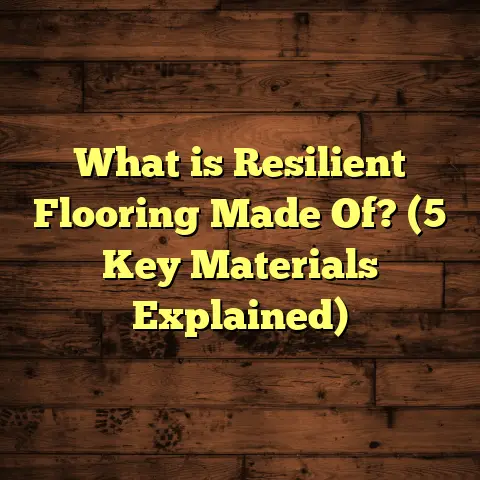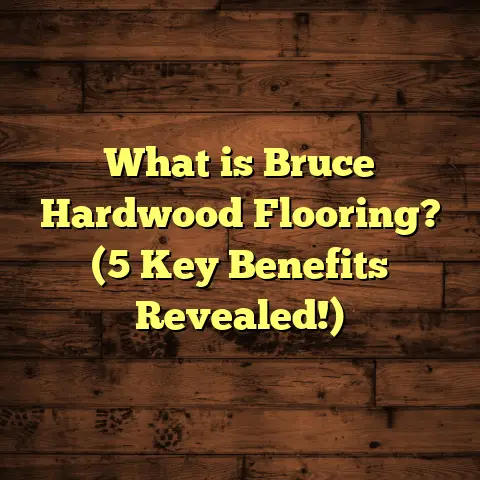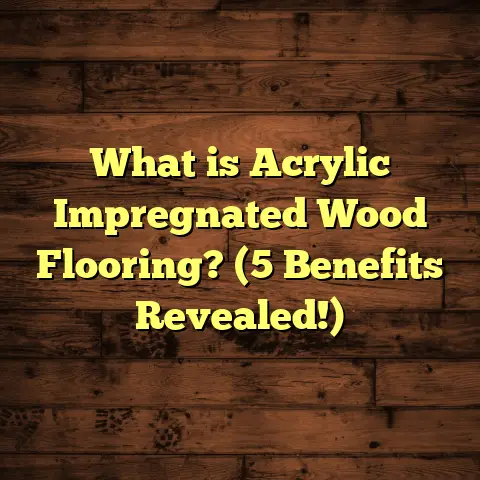What is Linoleum Flooring vs Vinyl? (5 Key Differences Revealed)
The weather’s been pretty unpredictable lately, hasn’t it? One minute you’re basking in warm sunshine, the next you’re scrambling for your umbrella because the skies opened up unexpectedly. And if you’re like me, all this weather back-and-forth makes you think about how the floors beneath your feet handle the changes. Floors that look great but can stand up to humidity, temperature swings, and occasional spills are a must-have in any home.
This brings me to something I get asked about a lot: linoleum flooring vs vinyl. People often confuse the two, even though they’re quite different in composition, durability, installation, and feel. As someone who has installed both types across many projects—from cozy homes to bustling commercial spaces—I want to share what I’ve learned over the years.
Let’s break down what linoleum and vinyl really are, how they compare, and which might be better for your specific needs.
What is Linoleum Flooring?
I always like to start with linoleum because it’s the older sibling in this story—around since the 1860s! Linoleum is a natural flooring material made from renewable ingredients like linseed oil (which is why it’s called “linoleum”), cork dust, wood flour, pine resin, and natural pigments. These components are mixed and applied onto a backing of jute, a strong natural fiber.
When I first encountered linoleum as a flooring option, I was surprised by how different it felt compared to vinyl. It has this soft yet firm texture underfoot that feels almost alive, probably because it breathes a little—allowing air to pass through. This breathability helps reduce moisture buildup underneath, which can be a problem with less porous floors.
Why Linoleum Has Stuck Around
Despite being one of the oldest flooring materials out there, linoleum has stayed relevant because of its:
- Eco-friendliness: Made from natural materials, linoleum is biodegradable and a favorite among people who want sustainable options.
- Durability: When cared for properly, linoleum can last between 20 and 40 years. That’s longer than most vinyl products.
- Aesthetic: Linoleum often comes in solid colors or subtle marbled patterns. It develops a warm patina over time that adds character.
- Comfort: It’s softer underfoot than many hard surfaces like tile or hardwood.
I remember installing linoleum in a family home where the client wanted something hypoallergenic and low-VOC (volatile organic compounds). Linoleum was perfect since it doesn’t off-gas harmful chemicals like some synthetic floors can.
How Linoleum is Made
The production process involves oxidizing linseed oil into a thick substance called linoxyn. This combines with other natural ingredients to create a resilient surface. It’s then rolled onto the jute backing and cured.
Because of its natural ingredients, linoleum tends to have a matte finish rather than the shiny gloss you see on vinyl. The colors come from natural pigments, which means they’re less likely to fade dramatically over time.
What is Vinyl Flooring?
Vinyl flooring came along much later—starting in the mid-20th century—as a synthetic alternative designed to mimic other floor materials while offering more water resistance and easier maintenance.
Vinyl is made from polyvinyl chloride (PVC), plasticizers, stabilizers, pigments, and other additives. It’s manufactured in several forms:
- Sheet vinyl: Large continuous rolls.
- Vinyl tiles: Usually 12×12 inches or similar sizes.
- Vinyl planks: Mimicking wood plank flooring.
What caught my attention early on with vinyl was its versatility. The printing technology used today can replicate wood grain, stone textures, even concrete looks almost perfectly.
Why Vinyl Took Off
Vinyl is popular because:
- It’s affordable: Vinyl generally costs less than linoleum.
- Waterproof: Unlike linoleum, vinyl creates a moisture barrier.
- Easy to install: Especially peel-and-stick tiles or click-lock planks.
- Low maintenance: Wipe spills quickly and use mild cleaners.
- Design variety: Endless styles allow customization.
I’ve installed vinyl floors in apartments that see heavy foot traffic and even in restaurants where spills are constant. Vinyl holds up well in these tough environments.
How Vinyl is Made
Vinyl production involves mixing PVC with plasticizers to make it flexible. This mixture is layered with printed designs and protective coatings before being pressed into sheets, tiles, or planks.
The top layer usually includes a clear wear layer that protects against scratches and stains. Quality varies widely—higher-end vinyl has thicker wear layers for longer life.
5 Key Differences Between Linoleum and Vinyl Flooring
Now comes the good part: the five major differences you should know before choosing between linoleum and vinyl. These differences will help you decide what works best for your lifestyle and space.
1. Composition: Natural vs Synthetic
The biggest difference is what each floor is made of.
Linoleum is mostly natural—97% according to technical data sheets—with ingredients sourced from plants and minerals. This makes it biodegradable and less harmful to the environment during disposal.
On the other hand, vinyl is mainly synthetic plastic (PVC), over 90% plastics by volume. This means vinyl isn’t biodegradable and has a larger environmental footprint during production and disposal.
Why does this matter? If reducing your home’s environmental impact is important, linoleum might be the better choice. But if you need water resistance or a specific look that linoleum doesn’t offer, vinyl may be worth considering despite its synthetic nature.
2. Durability and Lifespan
I often get asked how long these floors last. Here’s what I tell clients based on my experience:
- Linoleum: 20 to 40 years with regular maintenance. Some vintage linoleum floors are still intact after 50+ years.
- Vinyl: Typically lasts 10 to 20 years depending on quality and traffic levels.
Linoleum’s durability comes from its dense natural composition which resists wear well but can get scratched or dented if hit hard or if heavy furniture slides across it untreated.
Vinyl’s wear layer protects against scratches but thinner products can peel or crack over time, especially in high-traffic areas.
3. Moisture Resistance
This one trips up a lot of people.
Vinyl floors are waterproof. Because they are plastic-based with sealed edges (especially in plank or tile form), they keep water from seeping through to the subfloor. This makes vinyl ideal for bathrooms, kitchens, basements—anywhere spills or humidity are common.
Linoleum is water-resistant but not waterproof. While it tolerates moisture better than wood or cork floors, excess water can cause it to swell or warp if not sealed properly.
I worked on a kitchen renovation where we used linoleum but had to apply special sealants every few years to protect against water damage. Without sealing, water caused some edges to lift after repeated exposure.
4. Installation Process
Installation can make or break your experience with either floor.
Linoleum installation requires more expertise:
- The floor must be acclimated (left in the room for days) before installation.
- Subfloor preparation must be thorough—clean, smooth, dry.
- Linoleum sheets need professional adhesive application.
- Seams are heat-welded or glued carefully for durability.
- The material is heavier and less forgiving during cutting and fitting.
In my experience, linoleum installation takes roughly double the time of vinyl for the same room size due to these factors.
Vinyl installation is far more DIY-friendly:
- Peel-and-stick tiles require minimal tools.
- Click-lock planks snap together quickly.
- Sheet vinyl can be glued down but also comes in loose lay options.
- Subfloor preparation is still important but less demanding than linoleum.
For homeowners wanting quick results without hiring pros, vinyl often wins here.
5. Appearance & Design Options
When it comes to looks:
Linoleum offers solid colors or subtle marbled patterns—mostly muted tones that develop an aged patina over time. Its natural pigments give it a unique warmth you won’t find in synthetic surfaces.
Vinyl dazzles with endless patterns—from photorealistic wood grains to bold geometric tiles. Modern printing technology allows manufacturers to replicate almost any look imaginable.
If you want your floor to look like real hardwood without the cost or maintenance, vinyl usually pulls ahead here.
Personal Stories From My Flooring Projects
Over the years, I’ve installed thousands of square feet of both linoleum and vinyl floors. Here are some experiences that might resonate with you:
One older couple wanted to restore an original 1920s bungalow’s charm but needed modern durability. We went with linoleum because it fit their eco-friendly mindset and gave their kitchen that vintage look they loved. Ten years later, the floor still looks great despite daily cooking messes and grandkids running through the house.
In contrast, I did a rental apartment complex where tenants changed often and spills were frequent. Vinyl was perfect there—it was cheap to replace damaged tiles and easy to clean between renters without deep maintenance.
Another interesting case was a coastal home where humidity wreaks havoc on floors every year. We chose luxury vinyl planks with waterproof locking edges for peace of mind—and it held up beautifully through storms and salt air exposure.
Data That Might Surprise You
Some numbers help put things in perspective:
- According to the Resilient Floor Covering Institute (RFCI), vinyl flooring accounts for roughly 60% of all resilient floor sales in North America due to affordability and variety.
- The Linoleum Manufacturers Association states that modern linoleum flooring can have an average lifespan exceeding 30 years under normal residential use.
- In one study comparing environmental impacts (Life Cycle Assessment), linoleum showed significantly lower greenhouse gas emissions over its lifespan compared to vinyl.
- A flooring installer survey revealed that nearly 70% of professionals find vinyl easier to install than linoleum.
How Climate Affects Your Flooring Choice
Weather isn’t just about comfort—it impacts your floor’s performance too. From hot sun to freezing cold, here’s how climate plays into choosing between linoleum and vinyl:
| Climate Type | Flooring Recommendation | Why? |
|---|---|---|
| Humid/Tropical | Vinyl | Waterproof; resists mold/mildew |
| Dry/Arid | Linoleum | Breathable; stable in dry air |
| Cold/Temperate | Mixed (Vinyl in wet areas; Linoleum elsewhere) | Combines moisture protection + comfort |
| Coastal | Vinyl (with waterproof sealing) | Resists salt air corrosion |
Understanding how your local weather affects materials can save you costly repairs later on.
Maintenance: Keeping Your Floor Looking Great
Both floors have their care tips that can extend their life considerably:
Linoleum Care
- Clean regularly with warm water and mild soap—avoid harsh chemicals.
- Apply polish every few months for shine and protection.
- Seal edges and joints every few years if exposed to moisture.
- Use furniture pads to prevent dents.
Vinyl Care
- Wipe up spills immediately.
- Use non-abrasive cleaners.
- Avoid waxing—modern vinyl has protective coatings.
- Replace damaged planks/tiles easily without full replacement.
From my experience coaching homeowners on floor care routines, those who stick to these simple tips get good results for years.
Cost Comparison: Budgeting Your Flooring Project
Cost is always a hot topic when choosing flooring. Here’s a rough breakdown based on current market prices:
| Flooring Type | Material Cost per Sq Ft | Installation Cost per Sq Ft | Total Estimated Cost (Avg House) |
|---|---|---|---|
| Linoleum | $3 – $7 | $3 – $6 | $6 – $13 |
| Vinyl | $1 – $5 | $1 – $4 | $2 – $9 |
Linoleum tends to be pricier upfront due to material expense and more involved installation. However, its longevity can offset initial costs over time.
Vinyl offers more budget flexibility—ideal for short-term solutions or renters—but may need replacement sooner depending on traffic.
Environmental Impact: What You Should Know
If sustainability matters to you as much as I suspect it does for many folks nowadays:
- Linoleum’s natural ingredients mean less pollution during manufacturing.
- It’s biodegradable at end-of-life—won’t add much waste to landfills.
- Vinyl production involves petroleum-based plastics releasing VOCs during manufacture.
- Disposal of vinyl adds plastic waste concerns unless recycled properly (which isn’t always easy).
So if you want your home footprint lighter on the planet, linoleum usually scores higher points here.
Case Study: Residential Kitchen Flooring Switch
A client called me after their old vinyl floor started peeling in their kitchen due to moisture damage. They were debating whether to replace it with new vinyl or try linoleum this time around.
We looked at:
- Their budget ($4k max)
- Moisture levels (moderate humidity)
- Desired look (warm natural tones)
After weighing pros/cons, we went with high-quality sealed linoleum with extra moisture barriers underneath. It took longer to install but transformed the space with its soft feel and rich colors.
Two years later? Still no issues—just compliments whenever guests visit!
Frequently Asked Questions About Linoleum vs Vinyl
Can you install these floors over existing flooring?
Yes—vinyl often goes right over tile or wood if flat enough. Linoleum usually requires removal of old flooring for best results due to adhesive needs.
Which floor is better for radiant heating?
Linoleum conducts heat well due to its natural composition—good choice for radiant systems. Vinyl can also work but check manufacturer specs for heat tolerance.
Do pets damage these floors?
Both hold up well but sharp claws can scratch linoleum more easily if not sealed properly. Vinyl tends to resist scratches better but can tear under extreme wear.
Are these floors allergy-friendly?
Linoleum is hypoallergenic since it doesn’t trap dust or allergens easily; also low VOC emissions help indoor air quality. Vinyl varies depending on finishes but newer products meet strict VOC standards now.
Wrapping Up My Thoughts
Choosing between linoleum and vinyl isn’t just about picking a color or price tag—it’s about understanding what works best for your home’s environment, lifestyle, budget, and design preferences.
If you want something natural that lasts decades and don’t mind a bit of care—linoleum might be your best friend. If you want quick install options with tons of design variety at an affordable price—vinyl could be just right.
Either way, knowing these five key differences helps make your decision clearer:
- Natural vs synthetic composition
- Durability and lifespan
- Moisture resistance
- Installation complexity
- Appearance choices
Think about your climate too: humid spaces lean toward vinyl; drier climates suit linoleum better generally.
Have you tried either before? Or are you about to choose between them? Feel free to ask me about estimates or installation tips—I use tools like FloorTally regularly to provide accurate cost breakdowns based on your location!
Remember: your floors see daily life up close—they deserve thoughtful choices so they serve you well for years ahead.





